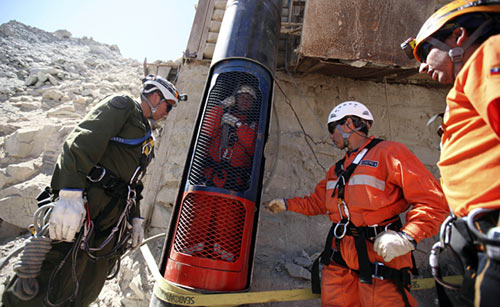Chile choreographs dramatic finish to rescue saga
Fresh air and freedom were just hours away Tuesday for the first of 33 miners trapped a half-mile underground for 69 days, men whose endurance and unity captivated the world as the Chilean government meticulously prepared their rescue. No one in the history of mining has been trapped so long and survived.
 |
|
Workers test the escape capsule being used to rescue the 33 trapped miners. [Agencies] |
"We made a promise to never surrender, and we kept it," Pinera said at about 5:45 pm local time (4:45 pm EDT), shortly before two rescue workers were expected to go down to prepare the miners for their trip. The president said the first miner will be brought up about two hours later.
Chile has taken extensive precautions to ensure the miners' health and privacy, sending down Navy special forces paramedics to prepare them for the trip and using a screen to block the top of the shaft from more than 1,000 journalists at the scene.
The miners will be ushered through an inflatable tunnel, like those used in sports stadiums, to an ambulance for a trip of several hundred yards (meters) to a triage station for an immediate medical check. They will gather with a few family members, in an area also closed to the media, before being transported by helicopter to a hospital.
Each ride up is expected to take about 20 minutes, and authorities expect they will be able to haul up roughly one miner an hour. The rescue of the last miner will end a national crisis that began when a cave-in sealed off the gold and copper mine Aug 5.
The only media allowed to record them coming out of the shaft will be a government photographer and Chile's state television channel. Their images will be delayed about 30 seconds or more to prevent the release of anything unexpected.
The worst technical problem that could happen, rescue coordinator Andre Sougarett said, is that "a rock could fall," potentially jamming the capsule partway up the shaft. But test rides suggest the ride up will be smooth.
Panic attacks are the rescuers' biggest concern. The miners will not be sedated -- they need to be alert in case something goes wrong. If a miner must get out more quickly, rescuers will accelerate the capsule to a maximum 3 meters per second, Health Minister Jaime Manalich said.
Mining Minister Laurence Golborne, whose management of the crisis has made him a media star in Chile, said authorities had already thought of everything.
"There is no need to try to start guessing what could go wrong. We have done that job," Golborne said. "We have hundreds of different contingencies."
As for the miners, they were kept busy Tuesday making final preparations "to keep their spirits up," Manalich said. He added that they were doing well: "It remains a paradox -- they're actually much more relaxed than we are."
Rescuers finished reinforcing the top of the 2,041-foot (622-meter) escape shaft early Monday, and the 13-foot (four-meter) tall capsule descended flawlessly in test runs. The white, blue and red capsule -- the biggest of three built by Chilean navy engineers -- was named Phoenix I for the mythical bird that rises from ashes.
 0
0 







Go to Forum >>0 Comments